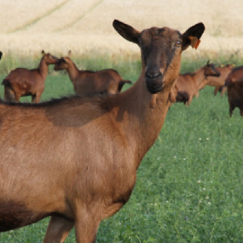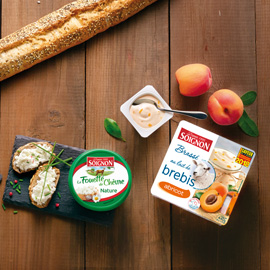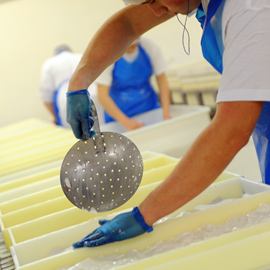Origins of Soignon Milk
The first important thing that goes into delicious Soignon products is our farmers’ passion for what they do. Then add good milk from our goats, along with a dash of our employees’ expertise and commitment, and that’s the recipe for our much-loved goat cheeses and yogurts! We will show you exactly the route our goat milk takes, from our farms to your table. Let us show you the way!
In the beginning there was milk...
We are a cooperative, so did you know that we collect our Soignon goat milk from about 600 different farmers? That milk is then used to make our tasty goat milk cheeses and yogurts. Working in this way means that you can trust us, because we guarantee that we can trace exactly where each drop of goat milk in our products came from.
Our farms: where our savoir-faire started out
Our farms are mainly located in northwestern France (Poitou-Charentes, Centre, Pays de la Loire, Brittany), but there are some are in Drôme (southwestern France) as well. The goats have to be in excellent health if we want them to produce quality milk. So our veterinarians and technicians provide our farmers with support and advice on what to feed their goats, how to treat them, how to get the best possible milk, and more.
The goats are milked in the morning and evening, 365 days a year. Our farmers take advantage of that special time to make sure that their goats are healthy on a daily basis... The goats’ udders and the milking machines are also cleaned daily, since cleanliness is just as important on our goat farms as it is in our cheesemaking facilities.

Did you know?
A single goat produces about 3 liters of milk per day.
During milking, the milk is sent straight to a storage tank (the milk tank). It chills the milk and keeps it stable at a temperature between 2°C and 4°C. These storage conditions ensure that the goat milk is preserved as best as possible. If a goat is sick and being treated, their milk will not be mixed with the rest of the milk, so it won’t contaminate the contents of the tank.
Looking to follow the milk's tracks? We know the way by heart!
Every other day, one of our cooperative’s dairy drivers drives a tanker truck from farm to farm to collect the milk. They also help ensure the quality of our milk by taking a sample from each farm’s tank. These samples are then tested to check the milk’s quality and ensure it is traceable. The dairy driver starts their rounds early in the morning, visiting about 8 to 10 farms to fill up their 25,000-liter tank with excellent milk from our farms.
We don't play the goat...
Our main priority is making good products that ensure we are worthy of your trust. From receiving the milk at our manufacturing sites to shipping our finished products, each step requires demanding know-how and rigorous quality control.
Our milk has to show its credentials to gain entry into our dairy!
When the tanker truck gets to our dairy processing plant, we check the quantity of the milk. We also take and analyze samples to check its quality.
If the raw milk complies with our requirements, it is unloaded and transported to a refrigerated storage tank. However, if the collected milk is not compliant, the milk is set aside, identified, and will not be used.
All our good products come from our dairies
Soignon goat milk is turned into cheese or yogurt via very specific manufacturing processes, depending on the site’s savoir-faire.
- First, the milk is stored in a refrigerated tank.
- It might be standardized (when the milk is skimmed).
- The milk is then pasteurized to ensure it meets health standards. It is heated to at least 72°C for 20 seconds to kill any pathogenic microorganisms.

Did you know?
All Soignon products are made with pasteurized milk, except for the Saint Vincent log, which is made with thermized milk (heated between 57°C and 68°C instead). This means that they are safe for pregnant women.
- Adding lactic ferments and/or coagulants curdles the milk and helps it solidify. This is the first step to making cheese.
- The next step involves molding, draining, and salting the curd.
- The last step is aging the cheese in a cheese cellar. The natural ferments will form the rind and develop the cheese’s aromas and flavors.
The aging conditions (time, temperature, humidity, mold cultures, etc.) are specific to each site, and will give the cheese its characteristic taste and texture.
We perform constant checks on our products and equipment all throughout the process to ensure the quality is beyond reproach.

"Wrapped and ready to go": all that's left to do is savor it
Our aged cheeses are packaged in specific packaging that lets the cheese “breathe” and conserves all of its flavors. The cheese continues ripening until it reaches your table (the younger the cheese, the firmer its center; the older the cheese, the more its chalky center will have broken down). After they have been packaged, our yogurts and cheeses are boxed up and the boxes are stacked on pallets. The pallets are loaded onto a truck that will deliver them to your local supermarket in a few days. Our products are then put out on supermarket shelves just waiting for you to pick them and enjoy them.
At Soignon, all our farmers, technicians, and employees work together closely. This trust and mutual respect are behind our goat milk’s excellent quality and they also help us make our dairy products with that unique Soignon flavor!
